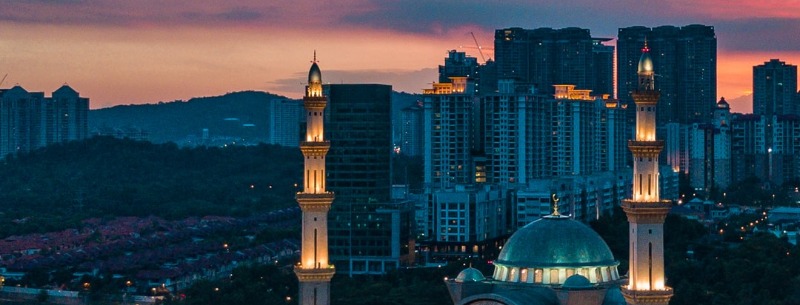Kuala Lumpur, capital city of Malaysia
Kuala Lumpur is not just an amazing capital city; the modern metropolis is a thriving monument to the determination and ingenuity that define Malaysia today. Once a humble tin-mining town, the city has grown into an urban wonder marked by Southeast Asia’s tallest skyscrapers and the riches of international commerce and trade. It is where historic mosques and temples sit side by side with space-age towers and where traders hawk everything from pungent durians to the latest bootleg DVDs. It is where many diverse cultures come together in a concrete jungle while still leaving their own indelible marks. In the midst of all this cosmopolitan grandeur lies numerous monuments and parks that retain the distinctly Malaysian spirit of the city while offering a peaceful respite from the hustle and bustle of urban life.
The 88-story Petronas Twin Towers are a symbol of the city. Once the world’s tallest buildings, the towers are joined 175 meters above street level by a double-decker Sky Bridge. From the bridge, brave visitors can enjoy a panoramic view of the city and beyond, stretching past the highrises to the mountains in the distance. The towers can still be appreciated at ground level for the faint of heart. One of the tower’s houses Southeast Asia’s premier classical music concert hall, home of the Malaysian Philharmonic Orchestra, and a park with walking paths, fountains and wading pools spans the area to the side of the towers.
The Petronas Twin Towers represent the present and future of the capital, but the Batu caves represent its past. Formed in a limestone hill, the three major caves and many smaller ones are one of the biggest tourist draws in the city, and for good reason. The Batu temple features 100-year old statues and idols in the midst of 400-million-year-old limestone formations. The most popular cavern is the Cathedral Cave with its awe-inspiring 100-meter tall arched ceiling. The strenuous hike up to the caves is worth every one of the 272 steps, but visitors should look out for bold and cheeky long-tailed macaque monkeys along the way.
Kuala Lumpur is a true melting pot of other cultures, resulting in thriving ethnic neighborhoods that feel like a whole different country. Little India has grown from a simple residential neighborhood to a bustling district filled with shops selling authentic Indian goods like colorful saris, fragrant flower garlands, exotic spices and the latest Bollywood music. In Chinatown, visitors can find bargains on everything from Chinese herbs to MP3 players and explore many temples. One of the area’s most famous is the Kuan Yin Temple, dedicated to the Goddess of Mercy. The vibrant temple houses three golden Buddha statues and is often filled with the sounds of priests chanting beautiful melodies.
The city is surrounded by lush jungles, but visitors can enjoy Malaysia’s flora and fauna without ever leaving Kuala Lumpur’s fantastic Bird Park, the world’s largest. More than 3,000 birds representing over 200 species call the park home, and the free-flight aviary offers close encounters with the most friendly species.
At night, the city lights up with excitement as throngs of revelers crowd the capital’s many bars, clubs, and pubs. The party starts at about ten but does not stop until the sun rises once again. For a glamorous night out, head to the Bukit Bintang district, where hip nightclubs burst with vibrant energy. To rub elbows with more locals than tourists, spend the night dancing under the neon lights in the Asian Heritage district or let your hair down in Kuala Lumpur City Centre, where lively bars bring life to the daytime financial district.
Kuala Lumpur Geographical Location
Kuala Lumpur is located on the western coast of Peninsular Malaysia and is Malaysia’s second-largest city.
The approximate population of Kuala Lumpur is 7,240,000 within the metropolitan area.
Kuala Lumpur Language
Malay is the official language of Malaysia while English is widely understood and spoken.
Kuala Lumpur Predominant Religion
- 60.5% Muslim
- 19% Buddhist
- 9% Christian
- 6% Hindu
- 4.5% Other
- 1% None
Confucianism, Taoism, and other traditional Chinese religions comprise a large portion of the “other” category.
Kuala Lumpur Currency
The Ringgit, also known as the Malaysian Dollar, is the official currency of Malaysia.
Kuala Lumpur Climate
It is usually hot throughout the year in Kuala Lumpur and consistent. Flooding is common with rainfall occurring every month and a monsoon season from October until March.
Kuala Lumpur Main Attractions
- Petronas Towers
- Menara KL Tower
- Batu Caves
Other Attraction in Kuala Lumpur
- Thean Hou Temple
- Sri Maha Sakthi Mohambigai Amman Temple
- Kuala Lumpur Bird Park
- Chinatown
